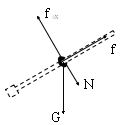问题
计算题
如图所示,质量为m的小球带有电量q的正电荷,中间有一孔套在足够长的绝缘杆上,杆与水平成α角,与球的摩擦系数为μ。此装置放在沿水平方向磁感应强度为B的匀强磁场之中,从高处将小球无初速释放,小球下滑过程中加速度的最大值是多少?小球运动速度的最大值是多少?

答案


题目分析:将小球由静止开始释放,小球受到重力、垂直于杆向上的洛伦兹力、垂直于杆的支持力和滑动摩擦力.开始阶段,洛伦兹力小于重力垂直杆向下的分力,杆对小球的支持力垂直杆向上,受力如图所示.


由牛顿第二定律有:
垂直杆方向:
沿杆方向:
又

小球向下做加速运动,洛伦兹力逐渐增大,支持力和滑动摩擦力逐渐减小,合力增大,加速度增大,当洛伦兹力等于重力垂直杆向下的分力时,支持力和摩擦力为零,合力最大,加速度最大,则有 .
.
此后,小球速度继续增大,当洛伦兹力大于重力垂直杆的分力时,杆对小球的支持力方向变为垂直于杆向下,受力情况如图所示,由牛顿第二定律有:
垂直杆方向:
沿杆方向:
又

可解得:
随着速度增大,滑动摩擦力增大,合力减小,加速度减小,当加速度减小到零,小球做匀速直线运动,速度达到最大,于是可得: 
解得:
